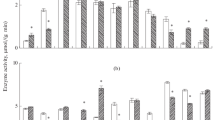Summary
The distribution of ecdysteroid binding sites in the stomach and gastrolith disc tissue of cryafish (Procambarus clarkii) was examined in relation to the molting stage by thaw-mount autoradiography. The radiolabeled hormone analogue ponasterone A (25-deoxy-20-hydroxyecdysone) was used. Ecdysteroid binding sites were demonstrated only in certain molting stages, the small gastrolith period and the aftermolt stage. In gastrolith epithelium, ponasterone A binding sites first appeared in the cytoplasm, and then in the nuclei and cytoplasm. In the stomach epithelium, many nuclear binding sites were detectable during the period of gastrolith secretion. These periodical changes in specific ponasterone A binding when correlated with the molting stages clearly show that ecdysteroids may function as an initiator for gastrolith formation and reabsorption. The findings also suggest that ecdysteroids control calcium transport in the stomach epithelium. The time-related and functional differences of cytoplasmic and nuclear concentration of ecdysteroid receptors indicate the presence of cytoplasmic and nuclear receptors associated with specific actions.
Similar content being viewed by others
References
Ashburner M (1990) Puffs, genes, and hormones revisited. Cell 61:1–3
Bidmon HJ (1991) Developmental changes in the presence of ecdysteroid receptors in the central nervous system of third instar larvae ofSarcophaga bullata. Dev Brain Res 63:121–133
Bidmon HJ, Koolman J (1989) Ecdysteroid receptors located in the central nervous system of an insect. Experientia 45:106–109
Bidmon HJ, Sliter TJ (1990) The ecdysteroid receptor. Int J Invertebr Reprod Dev 18:13–27
Bidmon HJ, Stumpf WE (1991) Uptake, distribution and binding of vertebrate and invertebrate steroid hormones and time-dependence of ponasterone A binding inCalliphora vicina. Histochemistry 96:419–434
Bidmon HJ, Stumpf WE, Granger NA (1990) Uptake and binding of ponasterone A in the brain of fifth stadiumManduca sexta larvae. In: Borkovec AB, Masler EP (eds) Insect neurochemistry and neurophysiology. Humana Clifton Press, NJ, pp 405–408
Bidmon HJ, Granger NA, Cherbas P, Maroy P, Stumpf WE (1992a) Ecdysteroid receptors in the central nervous system ofManduca sexta: Their changes in distribution and quantity during larval-pupal development. J Comp Neurol (in press)
Bidmon HJ, Stumpf WE, Granger NA (1992b) Ecdysteroid receptors in the neuroendocrine-endocrine axis of a moth. Experientia 48:42–47
Blackmore PF, Beebe SJ, Danforth DR, Alexander NA (1990) Progesterone and 17α-hydroxyprogesterone: Novel stimulators of calcium influx in human sperm. J Biol Chem 265:1376–1380
Deak P, Zavorsky P, Maroy P (1988) Moulting hormone regulates its receptor level inDrosophila melanogaster. Insect Biochem 18:847–852
Gee JD, Whitehead DL, Koolman J (1977) Steroids stimulate secretion by insect Malpighian tubules. Nature 269:238–239
Natori S, Ohtaki T (1976) Uptake of α-ecdysone by the fat body and membrane vesicles of fat body cells ofSarcophaga peregrina. J Insect Physiol 22:227–234
Spindler KD, Dinan L, Londershausen M (1984) On the mode of action of ecdysteroids in crustaceans. In: Hoffmann JA, Porchet M (eds) Biosynthesis, metabolism and mode of action of invertebrate hormones. Springer, Berlin Heidelberg New York, pp 255–264
Stumpf WE (1976) Techniques for the autoradiography of diffusible compounds. In: Prescott DM (ed) Methods in cell biology XIII. Academic Press, New York, pp 171–193
Travis DF (1960) The deposition of skeletal structures in the crustacea. I. The histology of the gastrolith skeletal tissue complex and the gastrolith in the crayfish,Orconectes (Cambarus) virilis Hagen-decapoda. Biol Bull 118:137–149
Ueno K, Ohsawa F, Natori S (1983) Identification and activation of storage protein receptor ofSarcophaga peregrina fat body by 20-hydroxyecdysone. J Biol Chem 258:12210–12214
Ueno M (1980) Calcium transport in crayfish gastrolith disc: Morphology of gastrolith disc and ultrahistochemical demonstration of calcium. J Exp Zool 213:161–171
Wilkstrom AC, Bakke O, Okret S, Bronnegard M, Gustafsson JA (1987) Intracellular localization of the glucocorticoid receptor: evidence for cytoplasmic and nuclear localization. Endocrinology 120:1232–1242
Author information
Authors and Affiliations
Rights and permissions
About this article
Cite this article
Ueno, M., Bidmon, H.J. & Stumpf, W.E. Ecdysteroid binding sites in gastrolith forming tissue and stomach during the molting cycle of crayfishProcambarus clarkii . Histochemistry 98, 1–6 (1992). https://doi.org/10.1007/BF00716931
Accepted:
Issue Date:
DOI: https://doi.org/10.1007/BF00716931




